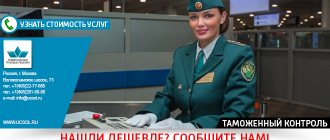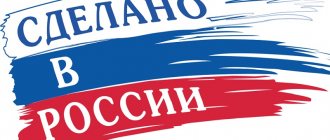What is customs inspection
This is a form of control, the essence of which is to conduct an inspection of goods and vehicles transporting them, followed by the removal of seals, seals and other identification means, as well as opening the packaging of goods or the cargo space of a vehicle or containers, containers and other places where goods are or may be located . All this is performed only by specially authorized employees of the Federal Customs Service (FCS).
The inspection process begins after the customs declaration for goods is accepted , because only then does the declaration have legal status. However, there are exception situations when the procedure can be carried out without this document:
- if identification of goods imported into the territory of the Russian Federation is required (for example, when registering internal customs transit);
- if it is necessary to verify information about violation of the customs legislation of the Russian Federation;
- if control is carried out according to the random inspection rule.
How is it different from customs inspection?
Another form of control is inspection of goods and vehicles . In general terms, it is similar to inspection, but they have characteristic differences.
So, customs inspection also involves checking cargo and transport, but at the time of inspection, seals and seals on products and (or) cargo compartments remain intact. The rest of the customs verification means also do without opening the packaging of goods and hand luggage, without dismantling or otherwise damaging the safety of the objects being checked and other parts.
Inspection, in turn, is associated with counting, measuring, studying the compliance of goods with the information in the submitted documents by opening the packaging of goods, vehicles, their cargo compartments and other places, damaging their seals and other verification means, dismantling and other damage to the safety of the objects being inspected and the remaining parts.
Also, the difference between them is that all goods and vehicles moving through border posts are subject to inspection. But the inspection is carried out in certain situations :
- In case of discrepancy between the documentary data on the product or the absence of the full name and six-digit codes of the goods. At the same time, the rules state: if the person authorized in relation to the vehicle provides the missing data within 24 hours from the date of presentation of the documents, the inspection will not be carried out.
- In case of detection of discrepancies between the declared and actual information after the use of technical means of customs control.
- The cargo compartment of the vehicle is not sealed and you can freely look into it.
- The customs committee received an order from other law enforcement agencies or government agencies on the need to conduct an inspection.
- Customs officers have reasonable suspicions of violation of customs legislation.
Who appoints and when
The customs inspector appoints an inspection and entrusts it to authorized FCS employees . Typically, this procedure affects cargo placed under the following procedures:
- arrival of goods to the customs territory of the Customs Union (CU);
- departure of goods from the customs territory of the Customs Union;
- customs transit;
- temporary storage of goods;
- customs declaration of goods;
- release of goods.
The inspection is carried out after registering the declaration for the goods.
Note. In some cases, this procedure is carried out before filing a declaration. But then the cargo must be inspected in the presence of the declarant.
The previous paragraph discussed the main situations for conducting an inspection. But it is worth noting that this procedure is sometimes carried out without the declarant or his representatives . This occurs exclusively in the presence of witnesses and under the following circumstances:
- The declarant or his representative simply did not appear before the deadline for filing the declaration.
- There is a threat to national security, the environment, or the like.
- The product is sent by international mail.
- Cargo or transport has been left on the customs premises in violation of the customs regime providing for the export of goods (vehicles).
Presence (absence) of the car owner
Inspection of a vehicle in the absence of its owner is permitted only in extreme cases, for example when there is a real threat to the life or health of citizens. However, in practice, officials often abuse this basis, which, in turn, can serve as an argument for the court to reject evidence obtained by violating the current legislation (Part 3 of Article 26.2 of the Code of Administrative Offenses of the Russian Federation). In addition, according to the Administrative Regulations introduced in 2021, the driver of the vehicle, as well as its passengers, must leave the vehicle during an inspection and remain close to the employees conducting the inspection. This requirement should not be neglected, especially when inspecting the luggage compartment of a vehicle.
Types of inspection
The concept of inspection is divided into two categories. The first is related to the grounds (risks) of its implementation , and here the following types are distinguished:
- main – the usual procedure determined by the technology of checking the customs declaration;
- a repeat is carried out to check and clarify data on the main check already carried out;
- directed to verify information about the movement of goods and vehicles in violation of established prohibitions and restrictions, as well as to detect facts of concealment from customs control;
- identificational.
The second category defines various degrees of inspection of goods and vehicles. Among them:
- verification with recalculation of cargo items and their weighing;
- with selective opening of cargo packages;
- with the opening of all cargo packages;
- with recalculation of the number of goods in cargo spaces and other inspection options.
Presence (absence) of witnesses
In accordance with the requirements of Article 27.9, at least two real disinterested citizens must take part in the vehicle inspection procedure, who will be present from the beginning to the end of the inspection.
Important! An official cannot appear in the protocol as a second witness. In this case, it is the responsibility of the police to find third parties. Mentioning fictitious citizens in a document is an unacceptable violation of the law. If there are such violations, the car owner has grounds to recognize the procedure as illegal.
In addition, it is important to pay attention to the witnesses themselves. In some cases, for lack of anything better, unreliable citizens are brought in as such, for example, those who are intoxicated or who raise doubts about their legal capacity. If such a fact occurs, it is important to record it in the protocol in order to subsequently be able to appeal the actions of officials.
How does the procedure work?
During the procedure, the integrity of previously installed seals and other possible means of identification is violated . Partial or complete dismantling of the inspected products is also possible if circumstances require it. An authorized FCS employee is prohibited from intentionally causing irreparable damage to cargo, except in cases aimed at protecting against offenses.
The entire procedure cannot last more than three days after the submission of the declaration and other documentation, that is, after making a decision on the inspection, the duration of the inspection cannot exceed two days. When transporting vehicles across the customs border, their inspection should not exceed the time established in the technological schemes.
Notification
An inspection cannot be carried out without a report and written permission from the head of the customs post (or the person performing his duties). They, in turn, are issued either on the basis of a random inspection or to identify a specific cargo. After making a decision to carry out the procedure, FCS employees notify the declarant or cargo owner about the upcoming inspection.
Conducting an inspection
The scope of inspection work varies : an employee has the right to inspect either 10%, 50%, or all 100% of imported products (depending on the instructions in the report).
A full inspection begins with the opening of all cargo items , including original packaging. Next, all markings, article numbers are photographed and all products are weighed.
Drawing up an act
After the inspection procedure is completed, a report is drawn up . It records the results of the inspection and attaches photographs. FCS employees draw up the document through the automated information system “Customs Inspection”. Next, the inspector who carried out the procedure puts his signature on the act. The carrier must be given a copy of the customs inspection report.
At the request of the declarant or if violations are discovered as a result of the inspection, the report is printed on paper and certified with the signature and personal seal of the employee who carried out the procedure. The document is also signed by the other participants in the process (the declarant or representative, witnesses, if any, etc.).
Reference. The inspection report is kept for three years. The calculation of the period begins on January 1 of the year following the year of registration of the act.
Please note that in case of violation of customs rules, a violation report is issued and then customs sanctions are followed against the importer and/or his cargo.
Methods that increase the efficiency of cargo control processes
In order to increase efficiency when checking vehicles, they resort to multi-stage inspection using super-sensitive X-ray equipment. For heavy-duty and railway transport, it is advisable to use integrated control systems. A convenient method is a multi-stage inspection where containers are inspected.
Modern inspection systems have a lot of advantages. Particular attention should be paid to:
- 24/7 work;
- readiness to work in any weather;
- high throughput;
- the possibility of inspection without opening the packaging (the method is safe if the cargo is fragile and/or valuable);
- deep analysis and high penetrating power;
- opportunities to bypass point-by-point inspection.
A number of the above factors help to increase the coverage of inventory items subject to inspection and reduce the time spent on vehicles staying at the inspection point.
Random and partial inspection
International postal items are subject to random checks . In such cases, the inspection is carried out using technical means of control.
During a partial inspection, a separate part of all declared goods is checked , however, as part of one declaration under one name, its results apply to all specified items. In this case, the declarant may require additional customs inspection of another part of the goods if he considers it impossible to extend the inspection results to the entire volume of the declared items.









